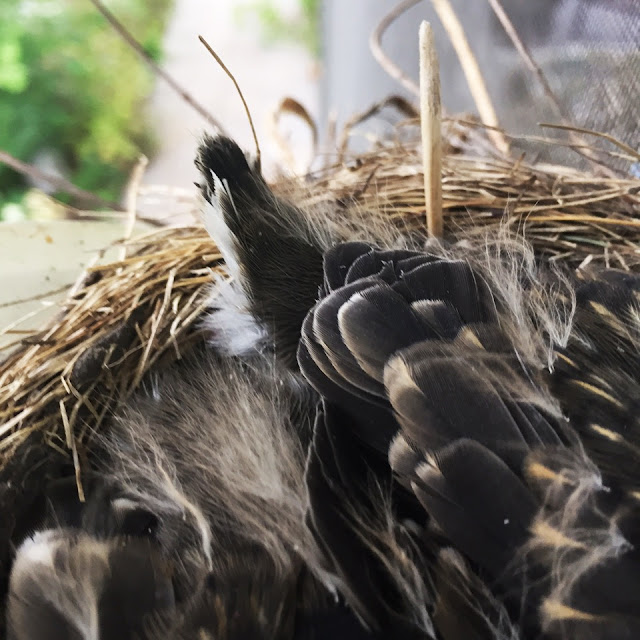Wings
The shape of a bird’s wing is important for producing lift. The increased speed over a curved, larger wing area creates a longer path of air. This means the air is moving more quickly over the top surface of the wing, reducing air pressure on the top of the wing and creating lift. Also, the angle of the wing (tilted) deflects air downwards, causing a reaction force in the opposite direction and creating lift.
Larger wings produce greater lift than smaller wings. So smaller-winged birds (and planes) need to fly faster to maintain the same lift as those with larger wings.
Wing loading tells you how fast a bird or plane must fly to be able to maintain lift: wing loading = weight/wing area (kilograms per square metre).
A smaller wing loading number means the bird/plane can fly more slowly while still maintaining lift and is more manoeuvrable.
July 6 no feathers just down visible
Feathers are actually complex branched skin appendages. A feather develops from a follicle, which is found in the dermal and epidermal layers of the skin. To me, the way the bird’s skin cells are able to develop a large, primary feather, complete with shaft, barbs and barbules is one of those miracles of nature. While a feather is actively growing from the follicle, there is one artery and one vein that runs through the feather to support the growth. Once the feather has reached the full size, the blood supply is no longer needed and the vessels shrivel up. However, the follicle maintains a blood supply in the skin. As the new feather emerges from the follicle, there is a sheath covering and surrounding the new feather. You will notice a silvery, shiny sheath on the new pin feathers.
July 7
Now we can see the flight feathers are forming from their pins. Now they are called pin feathers or blood feathers and they are receiving a copious blood supply to bring protein, pigments and other nutrients to the feathers. Because they are so large I think they may have been covered by the middle (and last hatched nestling) on the 6th
On about day 6 juvenile feathers emerged from their pins
July 8 Pin feathers are growing rapidly on first hatched but still sheathed
July 9 I can’t get over how long their toes are. The first hatched under the last hatched has real wing feathers now.
July 10 — Colours
July 11 Even the last hatched (on our left) now has sheathed wing feathers and the first hatched (on our right) feathers are looking beautiful
July 12— wow
July 13 Sheaths gone. Looking like three heads and wings…. wings wings wings but on the 14th we get to see TAIL feathers. Here we go
July 14 Look at that tail! (right below the word look)
I can still see the ear opening in the bird in the foreground but head feathers so will cover it completely










